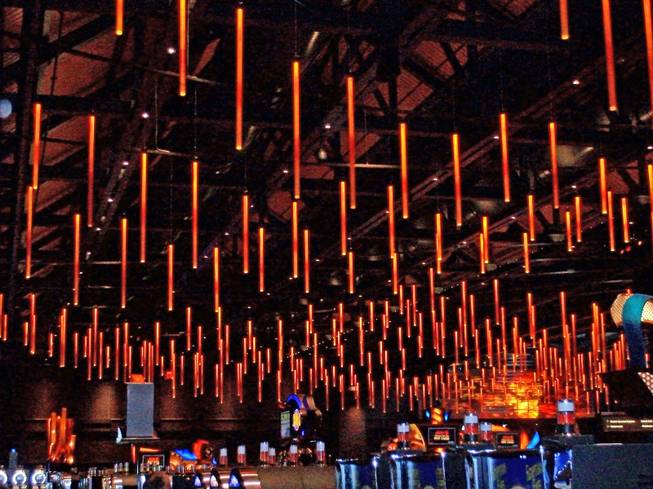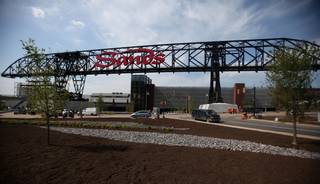
Mark Hansel
Glowing Sands: Light fixtures representing molten steel rods hang from the ceiling of Sands Bethlehem, which pays homage to the steel industry through its design and architecture.
Friday, June 12, 2009 | 3 a.m.
Sun Archives
- New Las Vegas Sands casino tops $1M a day (6-10-2009)
- Emeril cooking up new ideas for Las Vegas Sands (6-5-2009)
- Sands opens Keystone State casino (5-29-2009)
Sun Coverage
Sands Bethlehem casino, the newest offering from Las Vegas Sands Corp., had its official grand opening June 9.
The Bethlehem, Pa., casino actually opened its doors last month to capitalize on Memorial Day visitor traffic, but the grand opening marked the official welcoming of the $743 million property into the Lehigh Valley region.
So how did a Las Vegas-based resort company get the community of predominantly working-class, deeply religious people to embrace a casino?
The answer, according to locals, was a sincere effort by Las Vegas Sands to recognize the community’s history and heritage.
“Early on it was very clear that (Sands executives) got it,” Bethlehem Mayor John Callahan said. “They immediately understood what the city’s goals were and kind of made that work for them as well.”
Getting it is one thing; convincing the community of about 70,000 residents that this was not just a marketing ploy by a slick Las Vegas company to get a foothold and then take over was a little more difficult.
Bethlehem was founded in 1741 by Moravian settlers looking for an area to establish a community. For much of the first century of its existence, the community was exclusively Moravian and the Protestant group is still a dominant presence in the region.
In the late 1850s the company that would become Bethlehem Steel was formed and for the next 140 years, the words Bethlehem and steel were nearly synonymous.
The former Bethlehem Steel plant site that the casino sits on supplied the U.S. military with armaments and contributed to some of the country’s most recognizable landmarks such as the Golden Gate Bridge and the Chrysler Building.
The decline of the U.S. steel industry led to a gradual end of operations at the site, which closed for good in 1995.
Despite the lack of other options, it was clear that developing a casino on the most storied site in the city in a region that still has deep religious convictions would meet some opposition.
“Given this community’s origins, there was some resistance there,” Callahan said. “Gaming itself is controversial, but all along I always felt people would come around, and the polling bore this out. People were sort of 50/50 on gaming, but more than two-thirds approved of the Bethworks plan inclusive of gaming because they realized that was the only way to get (the site restored).”
Bethworks is the name of the steel plant formerly located on the site.
Sands Bethlehem President Robert DeSalvio said the company knew it was moving onto hallowed ground and reacted accordingly.
“The city was very afraid the land would get turned over to a large developer, every building would come down and they would put in big-box stores,” DeSalvio said. “That was the worst nightmare.”
Sands executives felt that if they could preserve parts of the site and design the casino to resemble adjoining buildings, the community would be much more receptive.
There is no question that the potential for profit was also a strong motivation. Casinos in Pennsylvania have a 20-mile exclusivity right, and about 1 million people live within half an hour of Sands Bethlehem. Stretch that out to 100 miles and the number grows to more than 17 million and includes New York City and some affluent northern New Jersey communities.
The city’s annual Musikfest, a 10-day event, draws more than 1 million people each year, so Las Vegas Sands officials knew the city could attract visitors.
“This community is already rich in tourism history, and that’s a great complement to what we’ve got,” DeSalvio said. “We felt we would add a nice component.”
Still, company officials felt that gaining support locally was crucial to the project’s success. Much of the workforce was expected to come from the area, as was almost half of the customer base.
Las Vegas Sands began winning community support more than three years ago by building a scale model of not just the casino, but the 124-acre former Bethlehem Steel plant, at a cost of $200,000. The idea was to demonstrate its commitment to do more than just drop a Las Vegas-style casino in the eastern part of Pennsylvania.
So far, Callahan says, the company has made good on that commitment.
“I’m very proud of the fact that the model looks like what was built,” Callahan said. “In fact, what was built looks better than what was promised.”
Although Callahan said the casino is not the savior of Bethlehem, it is definitely the savior of the steel plant site.
“In a broad sense, this is an opportunity for Bethlehem to realize a vision for that site that’s been 10 or 12 years in the making,” Callahan said. “That vision was to take that site and not just reuse, but preserve those buildings and maintain that sense of place in history and also breathe new life into the site.”
The casino is part of more than $2 billion in development projects in Bethlehem that Callahan says are transforming the city from a struggling steel town into a vibrant community with a strong sense of history.
Initially, the plan was to develop a museum on the Bethlehem Steel plant site and use that as an economic driver, but momentum for that idea stalled.
The entry of Las Vegas Sands breathed new life into that project, which is back on track.
The National Museum of Industrial History, which has the backing of the Smithsonian Institution, will showcase the nation’s industrial achievements and could be completed by late next year.
The company has donated land for a $53 million performing-arts facility, to be called Steel Stacks, on a site overlooking the blast furnaces.
ArtsQuest, a local charitable organization devoted to cultural activities in Bethlehem, and the local PBS affiliate are among the groups expected to find homes in the new facility.
“They are great community partners of ours, and we want to work with them as much as we can,” DeSalvio said.
Las Vegas Sands donated the profits from two test days last month to ArtsQuest and other local charities.
The Bethlehem area is also expected to receive more than $8 million annually, its portion of the state’s 55 percent tax on gross slot revenue.
Among the landmarks preserved on the site are the 20-story blast furnaces used for smelting ore and a giant ore bridge that now displays the Sands emblem.
Sands halted construction on a 300-room hotel, meeting space and a retail complex at the site because of economic woes.
Callahan said that although it is disappointing the hotel and retail sites had to be delayed, it is understandable and the Sands has clearly demonstrated its commitment to the project.
“Given the depths of the recession and the collapse of the financial markets and the struggles that Las Vegas Sands has gone through itself, it’s hard to imagine that this project would be immune,” Callahan said.
“I think it’s reasonable that given the fact that they are pretty far along on other aspects of the site that they have made that capital investment already.”
An expansion later this year will add restaurants and 2,000 more slot machines, bringing the total to about 5,000.
The casino expects to draw about 50 percent from the New York City area and upstate New Jersey, in addition to the 40 percent in local traffic. The rest will likely come from other parts of Pennsylvania, New York, New Jersey and Delaware.



Join the Discussion:
Check this out for a full explanation of our conversion to the LiveFyre commenting system and instructions on how to sign up for an account.
Full comments policy